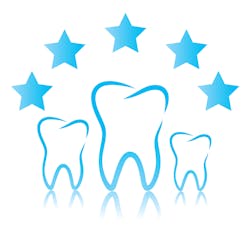Little things matter: Give patients a five-star welcome when they arrive
She is 89 years old and comes from an era where respect is afforded with the use of a title when being addressed. She doesn’t appreciate it when some “whippersnapper” hygienist (or any health-care provider) comes to retrieve her from the reception area and refers to her by her first name. So there!
She is my mother, and I am quoting her directly. Hence, for patients of that era, I defer to that preference and use Miss or Mrs. (Incidentally, my mother refuses to acknowledge the Ms. option, stating that it’s unnecessary pandering and why did they ever come up with that in the first place!) Keeping mindful, I make a point of this practice with my elders, unless I am invited to do otherwise.
The question becomes: At what age is it acceptable to refer to someone by a first name or, when best to stay with the more formal approach? Which makes patients feel more comfortable in this initial interaction? It would make sense to me that we err on the side of caution and go with formality. Patients might then correct us if they prefer that we call them by their first names, which many do. As one woman told me, “When you use my title and last name, I look around for my husband’s mother.” Another stated: “Please, I don’t need to feel any older than I already do.”
One dental office that I temped in took the usage of titles in a different direction and established a unique niche. Every patient, as well as all clinicians providing or assisting with treatment, was referred to with a title — young five-year old Johnny was “Master Smith.” Official handshakes for all age groups were part of the protocol. It was an interesting deviation from the informality that pervades much of today’s dental office world.
On a related note, I believe that new patients who are seen by the hygienist first should receive an introduction by the hygienist for the doctor when he or she enters the room. This is common courtesy. At Burlington County College where I teach clinically, dental hygiene students are expected to provide a formal introduction when the instructor comes over to check the medical history. Points are deducted for lack of professionalism if the student neglects to do so.
Seeing your back on the long walk back
It is also an interesting study to look at how we actually bring the patient back to our treatment room. One of my favorite employers, Dr. George LaPorte, made it crystal clear to me at my preliminary interview that “no patient of mine is ever to see your back.” He felt that it was inappropriate for the clinician to call out a person’s name in the waiting room, only to turn and have that person follow her down a hallway. “Not going to happen in my office if you wish to be employed here,” he said firmly.
We could offer directions. “After you, please. We will be in the second room on the left.”
Let the patient to lead the way with us following after? Probably not, I think. Sometimes clients get confused, or because they are anxious, they may not be listening. Or temporary dyslexia sets in. We say, “Turn right.” They turn left into the doctor’s operatory. It would seem that the best approach, given hallways with ample space would be to escort the patient Ritz Carlton style to the destination treatment room. I like it.
Another nuance that is important in the initial retrieval is the concept of knowing who your patient is so that you can make eye contact when you call out the name. If you have been in a practice for a long time, and know your patients, this is easy.
If not, why not ask someone who does have the familiarity to make you aware? Since the patient checks in at the front desk upon arrival, the receptionist usually knows who is who. It makes a great impression when you deliver direct eye contact. I knew of an office in Ocean, N.J., where digital camera photos of every patient were taken for the record, and updated each few years. Even temporary employees then had the ability to recognize those they were about to retrieve.
These nuances fall under the category of “little things that may mean a lot.” It can be a cold, impersonal medical world out there, and it is impressive to people when we polish the interaction with some five star initial approaches. Onward we go; it is in our hearts’ core.
ALSO BY EILEEN MORRISSEY:
United we stand: Hygienists need to support dentist's diagnosis
In line with alignment: Chiropractic care does benefit dental hygienists
EILEEN MORRISSEY, RDH, MS, is a practicing clinician, speaker, and writer. She is an adjunct dental hygiene faculty member at Burlington County College. Eileen offers CE forums to doctors, hygienists, and their teams. Reach her at [email protected] or 609-259-8008. Visit her website at www.eileenmorrissey.com.







